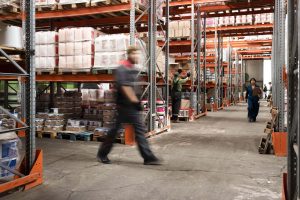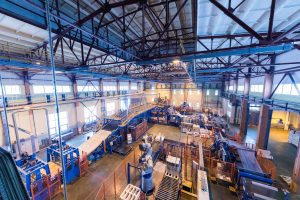Despite the rising pressure for faster, error-free order fulfilment, many third-party logistics (3PL) providers still rely on a mix of paper checklists, manual picking, and outdated warehouse software. The result? Missed SLAs, misplaced inventory, and growing inefficiencies, especially as eCommerce and omnichannel demand surge.
In high-velocity environments, manual effort cannot keep up with the speed, precision, and scale that modern supply chains demand. That is where smart warehouse systems, powered by robotics and intelligent automation, come into play. These systems are not just digitizing warehouse tasks but transforming how 3PLs operate, respond, and grow.
This blog explores how smart warehouse automation bridges critical gaps in 3PL operations, from eliminating human errors to enabling scalable, real-time decision-making.
1. The Hidden Inefficiencies in Traditional 3PL Warehousing
Many 3PL warehouses still rely on manual processes, barcode scans, inventory logs, and order checks, making them slow, prone to mistakes, and hard to grow. These problems are often not seen until busy times or complicated client requests bring them to light.
Decision-makers must use old or incomplete data when they can’t see what’s happening in real time. This causes shipments to be late and costs to go up. When you add in a lack of workers and more orders, it’s evident that manual operations can’t keep up.
3PLs require technologies that reduce human error, speed up throughput, and give them real-time operational information. Robotics-powered smart warehouse systems are designed to do all of these things.
2. What Makes a Warehouse System ‘Smart’?
A smart warehouse system does more than just automate fundamental tasks. It uses robots, sophisticated software, and real-time decision-making to make every part of fulfillment go more smoothly. These solutions reduce the need for human intervention and eliminate delays by automating picking, dynamic slotting, and real-time inventory changes.
What makes smart systems different is that they can sense, process, and respond without any help from people. They react right away to changes in demand, put urgent work first, and keep things running smoothly even when there are many of them.
In a 3PL setting where speed, accuracy, and flexibility are essential, smart warehouse solutions act as the operational nerve center, speeding up throughput while making fewer mistakes.
3. Human vs Machine: Why Automation Wins in High-Velocity 3PL
In fast-paced 3PL operations, even minor delays can ripple into missed SLAs and dissatisfied customers. Relying solely on human labor for repetitive tasks like picking, sorting, or replenishment introduces variability, including fatigue, errors, and slower response times.
Automation, on the other hand, delivers consistent speed, precision, and scalability. Robotic systems do not pause during peak hours or require retraining when product lines change. They work around the clock, maintain accuracy across thousands of SKUs, and free up human workers to focus on exception handling and oversight.
As 3PL providers scale to meet diverse client needs, automation becomes an efficiency booster and a competitive necessity.
4. Bridging Gaps in Throughput, Accuracy, and Traceability
Smart warehouse systems do more than automate tasks, they close operational gaps that traditional setups often overlook. With robotics handling movement and scanning, these systems ensure accurate, high-speed throughput without the errors that come from manual handling.
Inventory is tracked in real time, reducing mispicks and ensuring every item is accounted for at every stage. Integrated sensors and software create a digital thread of traceability—from inbound receipt to outbound delivery allowing 3PLs to respond faster to issues and provide clients with full visibility.
The result is a leaner, more reliable fulfilment engine that keeps operations running smoothly, even under pressure.
5. The 3PL Automation Advantage: Faster SLAs, Happier Clients
By automating picking, packing, and sorting, smart warehouse systems consistently meet or beat SLA targets no more scrambling to catch up during peak volumes. Faster cycle times translate directly into on-time deliveries, reduced chargebacks, and stronger customer trust. And because automation handles the heavy lifting, 3PLs can take on more clients and complex SKUs without sacrificing service quality.
6. Building a Scalable 3PL Tech Stack with Smart Warehouse Systems
Modern 3PLs need solutions that grow with them. Smart warehouse systems are modular: you can add more robots, integrate new software modules, or expand to multiple sites without a forklift-full of custom coding. Open APIs and plug-and-play hardware ensure that your WMS, TMS, and ERP all speak the same language, so you are ready for whatever comes next.
Conclusion: The Future of 3PL Is Autonomous, Not Just Agile
In high-stakes logistics workflows, manual workflows and siloed systems simply cannot keep pace. Robotics-driven smart warehouse systems bridge critical data and operational gaps delivering reliable throughput, pinpoint accuracy, and full traceability. For 3PL providers aiming to scale profitably and win long-term client loyalty, embracing automation is no longer optional; it’s the cornerstone of competitiveness.
Ready to see automation in action? Request a personalized demo today and discover how smart warehouse systems can transform your 3PL operations.
FAQ’s
Q1: How do smart warehousing systems really reduce mistakes in 3PL work?
A: Smart systems employ robots to pick and pack things, eliminating faults caused by hand scanning. They also receive real-time software upgrades. Every move is automatically recorded, so you can see where each object is. This smooth connection between hardware and software reduces mispicks and misplaced products.
Q2: Is it possible to connect smart warehouse automation to my current WMS or ERP?
A: Yes, for sure. Open APIs and plug-and-play modules are built into modern smart warehouse solutions. You can link your robotics platform to your present WMS or ERP without ripping and replacing anything. This lets you keep your old investments while getting the benefits of automation right away.
Q3: What type of return on investment (ROI) should 3PLs expect after implementing these technologies?
A: Most 3PLs report a 20–30% drop in labor expenses and a 15–25% rise in order accuracy within the first six months, but the exact percentages depend on the size of the operation and how many orders it handles. Faster cycle times also mean fewer chargebacks and happier customers, which means lower costs and better sales.





